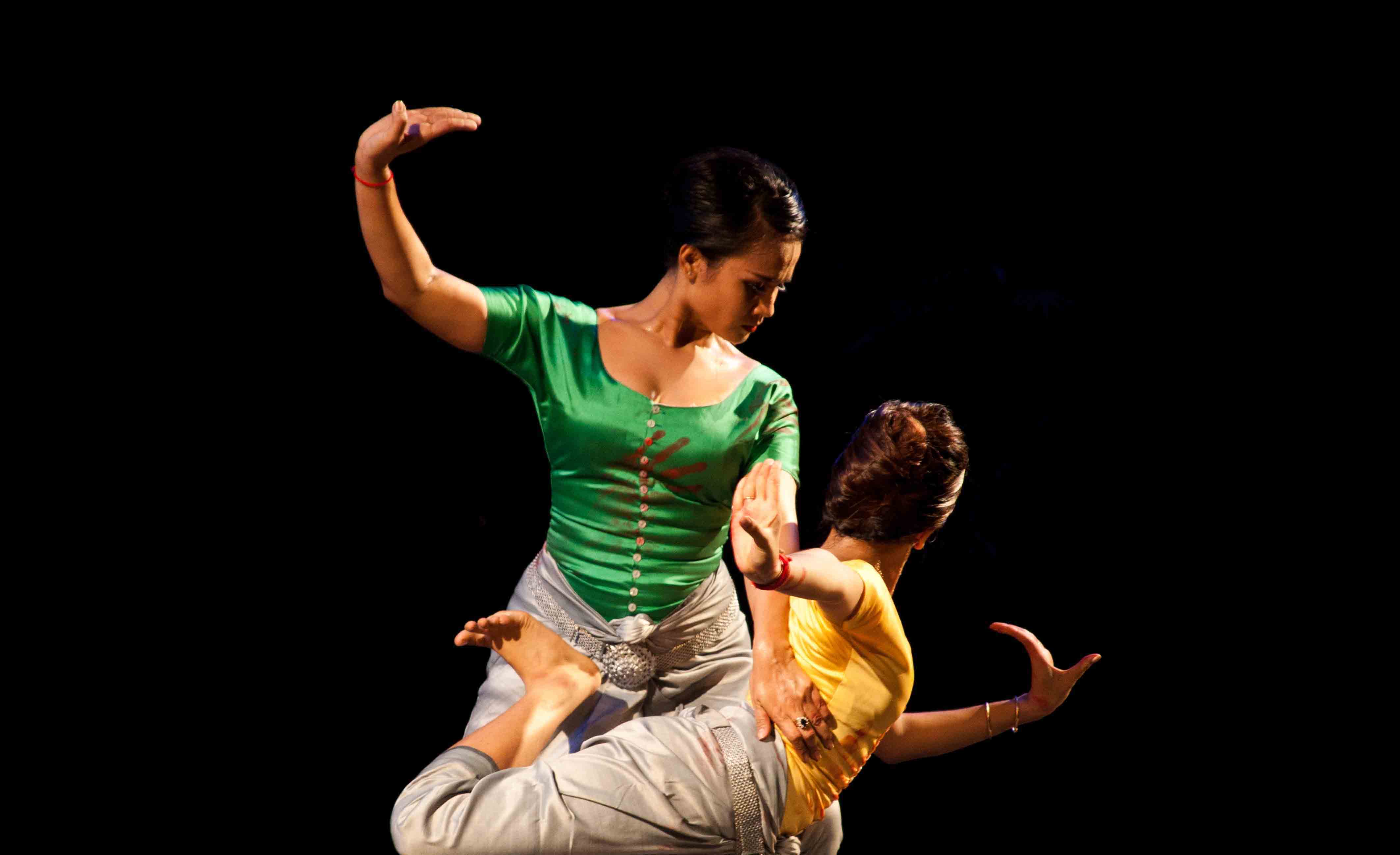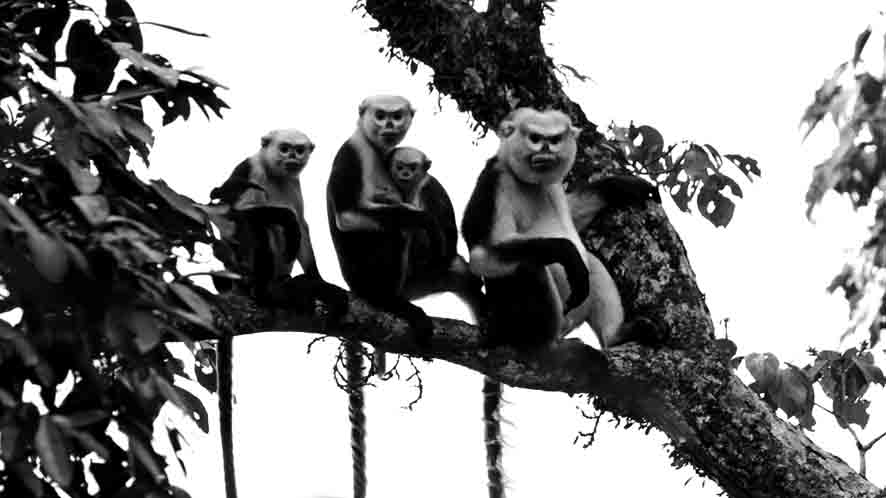Nothing remains of the original texts which might have demystified the meanings and gestures of dance in the ancient temples of Ankgor. What is known about these elaborate rituals is that they were performed not for mere mortals, but as offerings to the gods. One seventh-century inscription, as reported by Boreth Ly on AsiaSociety.org, details in Sanskrit how dancers were ‘donated’ to temples by patrons and devotees. King Jayavarman VII was among the most generous, gifting thousands during his 37-year reign.
As part of the annual buong suong ceremony, it would fall to the monarch to ask the heavens for help on behalf of the nation. The plea was duly conveyed by classical dancers, who, legend has it, became possessed by divine spirits until the dance was complete. These highly stylised vehicles of worship, known in Khmer as robam kbech boraan, finally took their rightful place on Unesco’s world heritage list of intangible and oral treasures in November 2003. The journey had not been a smooth one.
Guggenheim Fellow Sophiline Cheam Shapiro, Cambodia’s most celebrated choreographer, was eight years old when in 1975 most performers went into hiding for fear they’d be executed by the Khmer Rouge. Almost overnight, the art of classical dance was reduced to a vessel for Maoist rhetoric. By 1981, when the School of Fine Arts finally reopened, only a handful of classical dancers had survived. Among the first 111 students to enrol was Sophiline.
In the years that immediately followed, classical dance was once more repurposed as a political tool. A tale about two gods fighting over a crystal ball, originally intended to demonstrate the difference between ignorance and enlightenment, was transformed by the state into one of communism versus capitalism (ironically, the lofty references to Leninism and Marxism were lost on most of the audience, who craved cultural stimulation after years of violence).
Today, this centuries-old dance form is evolving at an unprecedented rate courtesy of Sophiline and her husband John Shapiro, who co-founded Khmer Arts here in 2002. From an exotic Takhmao theatre originally built by Okhna Chheng Phon, minister of culture from 1982 to 1989 and one of the chief architects of the revival of the traditional Khmer arts, their professional dance troupe has become the first to usher classical dance into the 21st century.
On April 7, Khmer Arts will lift the lid on their revolutionary approach to ancient dance forms in a jungle extravaganza marking the organisation’s tenth anniversary and Cambodia’s New Year. The theatre’s setting is suitably dignified: five smiling Bayonesque faces watch performances unfold from the top of a towering Angkorian backdrop. The Advisor joined Khmer Arts during a recent rehearsal to talk hand gestures, gods, and time travel.
Sophiline: “People consider classical dance a symbol of cultural pride, because it’s such a unique art form to Cambodia, but war and poverty and the lack of outreach programmes – these make people think art is the least important. But culture is an element in our lives that identifies who we are. Classical dance plays that role.
“The way people sit, the way people pose, the way people offer greetings: these are all manifestations of classical dance in the simplest way. Look at social dances, the circle dance: the rhythm is kind of slow; the hand gestures resemble those of classical dance. To create work like ours – using the classical form but addressing contemporary issues – is also important. And the more people know about hand gestures and the meanings behind the dance, the more they can appreciate it.”
John: “If you come to it knowing nothing, all you can do is appreciate the surface aesthetic. For example, Sophiline was commissioned to create a piece for a Vienna festival based on Mozart’s The Magic Flute. She said: ‘I’m supposed to do something with this? What the hell is it?!’ Then she read a book about symbolism in the Magic Flute, a book about the history of the Freemasons (the Magic Flute is about Masonic beliefs), and a book about the last year of Mozart’s life, when he composed the piece. Through deciphering the opera, she was able to make a parallel between that and the Khmer Rouge – the dangers of extreme rhetoric and how that leaves no room for compassion and no room to change policy. She used Cambodian characters and mythology to express the dangers of using and adhering to extreme ideology. That’s the deciphering process.
“The only complaints we hear is that people are tired of seeing the same five to seven classical dances over and over and over again. Just as if you’re a ballet fan, you don’t want to see The Nutcracker or Swan Lake every week. What people say – and this is young and old – is that they’re very appreciative of seeing something new – and in classical dance, we’re the only ones doing this in Cambodia.”
Sophiline: “Seasons of Migration, which I choreographed in 2005, is the first piece, in my knowledge, to attempt to address a contemporary issue – and that issue is culture shock, including identity crisis. Culture shock is a modern concept, especially with people who migrate from place to place, but it can also apply to people who move from the countryside to the city, or back. People such as myself, who moved to the US and then came back.
“It’s a contemporary creation, but the form is classical. When I was at the School of Fine Arts in 1981, my teachers thought classical dance should look back to the past and excavate historic knowledge. We only choreographed new work that related to mythology, but not looking forward and dealing with contemporary issues. But this work is based on a concept coming out of everyday life.”
John: “Seasons of Migration is about gods and goddesses coming to Earth to live among humans and how they experience culture shock.”
Sophiline: “One of the goddesses is a serpent and she has problems with her tail. She doesn’t like it. She wants to tear it off.”
John: “That’s because none of the humans have tails, so she feels out of place.”
Sophiline: “That was our attempt to bring the classical form into the present time and make it relevant to us, to our lives, today.”
John: “Classical dance comes out of that ritual prayer tradition, so the oldest dances – with one or two exceptions – are really, really slow. They weren’t meant for an audience. Nobody was watching except the gods. If you watch them now, they can be a little boring because not much happens. They’re so slow and so balanced. It’s a different kind of beauty.”
Sophiline: “Most of the time they stay in one place. Cambodia is not the way it used to be after the Khmer Rouge, when the country was completely destroyed. Now, people have some sophistication, so the art has to match the level the audience demands. Even if the dance is simple, it has to be as sophisticated, as elegant, as it can be.
“Our work isn’t changing classical dance, it’s adding to it. It’s the beginning of a new path, a new form, being created. We’re using new music, different costumes, and experimenting with the way it looks. I call it robam boran chnnaiy – neo-classical, or contemporary classical, dance.”
John: “Another thing that’s new is that, typically, classical dance features gods and goddesses, kings, princess, giants, animals. It’s about mythology. But one of our pieces is a dance with a man and a woman, who could be anybody, even though the male part is played by a female dancer.
Sophiline: “Stained is a piece about the trial by fire in the Ramayana, but in this piece I give the female character a chance to speak, to question, because most of the time we see her as a very modest, ideal woman. She doesn’t talk much and there’s something inside her that’s not revealed, particularly intellectually. Stained is focusing on what she thinks, what she says, what she wants to know. Why do things happen like this? Is it fair? She questions her husband. Usually, the male character is the one who decides things.”
Four pieces will be performed during the evening (“Don’t forget your mosquito repellent,” cautions John). Ream Eyso & Moni Mekhala is an ancient fertility dance that describes the origin of rain and for centuries has been used in ceremonies at the height of the dry season, and Seasons of Migration explores the four stages of culture shock first described by anthropologist Kalvero Oberg. Munkul Lokey is performed to New York composer John Zorn’s lush musical setting of the Song of Songs, perhaps the world’s first erotic verse, and Stained is Sophiline’s interpretation of Neang Seda’s trial by fire from the Reamker epic.
WHO: Khmer Arts
WHAT: 10th anniversary contemporary classical dance performance
WHERE: Khmer Arts Theatre, Street 115, Takhmao
WHEN: 7pm April 7
WHY: Classical dance forms with 21st century edge


